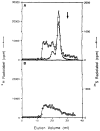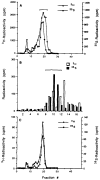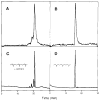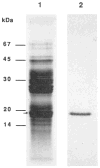Human lamin B contains a farnesylated cysteine residue
- PMID: 2684976
- PMCID: PMC3443689
Human lamin B contains a farnesylated cysteine residue
Abstract
We recently showed that HeLa cell lamin B is modified by a mevalonic acid derivative. Here we identified the modified amino acid, determined its mode of linkage to the mevalonic acid derivative, and established the derivative's structure. A cysteine residue is modified because experiments with lamin B that had been biosynthetically labeled with [3H]mevalonic acid or [35S]cysteine and then extensively digested with proteases yielded 3H- or 35S-labeled products that co-chromatographed in five successive systems. A thioether linkage rather than a thioester linkage is involved because the mevalonic acid derivative could be released from the 3H-labeled products in a pentane-extractable form by treatment with Raney nickel but not with methanolic KOH. The derivative is a farnesyl moiety because the Raney nickel-released material was identified as 2,6,10-trimethyl-2,6,10-dodecatriene by a combination of gas chromatography and mass spectrometry. The thioether-modified cysteine residue appears to be located near the carboxyl end of lamin B because treatment of 3H-labeled lamin B with cyanogen bromide yielded a single labeled polypeptide that mapped toward this end of the cDNA-inferred sequence of human lamin B.
Figures






Similar articles
-
Modification of nuclear lamin proteins by a mevalonic acid derivative occurs in reticulocyte lysates and requires the cysteine residue of the C-terminal CXXM motif.EMBO J. 1989 Dec 20;8(13):4007-13. doi: 10.1002/j.1460-2075.1989.tb08583.x. EMBO J. 1989. PMID: 2686979 Free PMC article.
-
Identification of geranylgeranyl-modified proteins in HeLa cells.Science. 1990 Jan 19;247(4940):320-2. doi: 10.1126/science.2296721. Science. 1990. PMID: 2296721 Free PMC article.
-
The CaaX motif is required for isoprenylation, carboxyl methylation, and nuclear membrane association of lamin B2.J Cell Biol. 1991 Apr;113(1):13-23. doi: 10.1083/jcb.113.1.13. J Cell Biol. 1991. PMID: 2007618 Free PMC article.
-
Evidence for modification of lamin B by a product of mevalonic acid.J Biol Chem. 1988 May 5;263(13):5997-6000. J Biol Chem. 1988. PMID: 3283116
-
Posttranslational modification of proteins by isoprenoids in mammalian cells.FASEB J. 1990 Dec;4(15):3319-28. doi: 10.1096/fasebj.4.15.2123808. FASEB J. 1990. PMID: 2123808 Review.
Cited by
-
Regulation of intracellular actin polymerization by prenylated cellular proteins.J Cell Biol. 1992 Apr;117(2):347-56. doi: 10.1083/jcb.117.2.347. J Cell Biol. 1992. PMID: 1560030 Free PMC article.
-
A protein geranylgeranyltransferase from bovine brain: implications for protein prenylation specificity.Proc Natl Acad Sci U S A. 1991 Jun 15;88(12):5302-6. doi: 10.1073/pnas.88.12.5302. Proc Natl Acad Sci U S A. 1991. PMID: 2052607 Free PMC article.
-
Posttranslationally processed structure of the human platelet protein smg p21B: evidence for geranylgeranylation and carboxyl methylation of the C-terminal cysteine.Proc Natl Acad Sci U S A. 1990 Nov;87(22):8960-4. doi: 10.1073/pnas.87.22.8960. Proc Natl Acad Sci U S A. 1990. PMID: 2123345 Free PMC article.
-
Specific isoprenoid modification is required for function of normal, but not oncogenic, Ras protein.Mol Cell Biol. 1992 Jun;12(6):2606-15. doi: 10.1128/mcb.12.6.2606-2615.1992. Mol Cell Biol. 1992. PMID: 1375323 Free PMC article.
-
Farnesylation or geranylgeranylation? Efficient assays for testing protein prenylation in vitro and in vivo.BMC Biochem. 2006 Feb 28;7:6. doi: 10.1186/1471-2091-7-6. BMC Biochem. 2006. PMID: 16507103 Free PMC article.
References
Publication types
MeSH terms
Substances
Grants and funding
LinkOut - more resources
Full Text Sources
Other Literature Sources
Molecular Biology Databases

